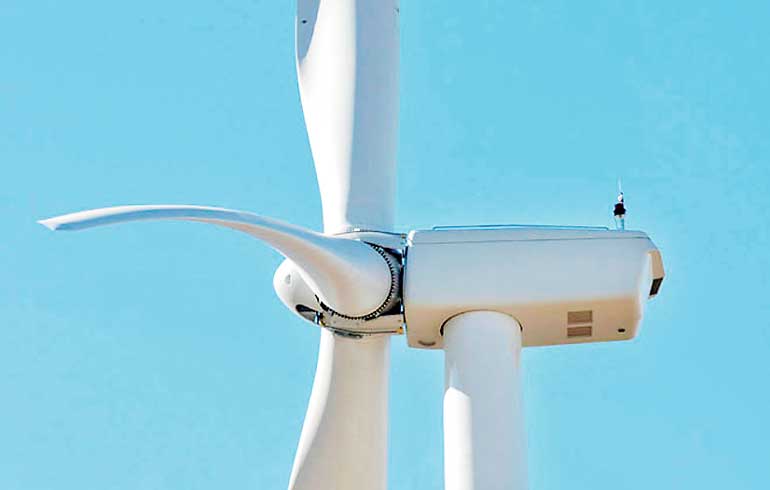Friday Jan 09, 2026
Friday Jan 09, 2026
Wednesday, 10 June 2015 00:00 - - {{hitsCtrl.values.hits}}

By Amila Withanaarachchi Department of Industrial Management University of Kelaniya
‘Energy can neither be created nor be destroyed, but it can be transferred from one form to the other’ – this is the basis of the world. Wind energy is nature’s gift to humanity. Harnessing the wind is one of the oldest methods of generating energy.
Since ancient times man has used the help of windmills to grind the harvest and to pump water. With the appearance of electricity at the end of the 19th century, the first prototypes of modern wind turbines were built, using technology based on the classical windmill.
The oil crisis of the 70s and even more the anti-nuclear power movement of the 80s, raised interest in alternative energies and the search for new ecologically and commercially viable ways of generating power intensified. In parallel to such movements and technology advancements, traditional wind mills have been replaced by specially designed wind turbines which enhance the productivity of electricity.
The blades of these modern wind turbines capture wind speed, thereby using its kinetic energy. The movement of these blades brings the shafts connected to them in motion. This generated motion leads to generate power in a generator which further produces electricity. Wind turbines mainly consist of blades, shafts, gears, generators and cable.
Wind power markets
By the end of year 2013, the global wind capacity reached 318GW making wind, the fastest growing renewable energy technology. Interestingly, over the last few years more new turbine capacity was added in developing countries and emerging markets than in OECD countries. A significant wind power capacity was added in the Chinese market reaching the total wind capacity in China to 91.4GW. The European Union remained the top region for cumulative wind capacity, with 37% of the world’s total, although Asia was nipping at its heels with more than 36%. China, United States, Germany, Spain, India, United Kingdom, Italy, France, Canada, and Denmark are respectively the top 10 countries accounted for 85% of year-end global capacity, but there are dynamic and emerging markets in all regions. By the end of 2013, at least 85 countries had seen commercial wind activity, while at least 71 had more than 10 MW of reported capacity, and 24 had more than 1 GW in operation.
Offshore wind power
Offshore wind power refers to the construction of wind farms in bodies of water to generate electricity from wind. Stronger wind speeds are available offshore compared to on land, so offshore wind power’s contribution in terms of electricity supplied is higher. The first offshore wind project was installed off the coast of Denmark in 1991. Since that time, commercial-scale offshore wind facilities have been operating in shallow waters around the world. Many countries have coastal areas with high wind resource potential. Worldwide there are 7GW of offshore wind energy installed in 14 countries.
Over 50 projects are operational in coastal waters of countries such as Denmark, the United Kingdom, Germany, Norway, the Netherlands, Japan, China, South Korea, Belgium, Sweden, Italy, Portugal and others. Commercial-scale offshore wind facilities are similar to onshore wind facilities. The wind turbine generators used in offshore environments include modifications to prevent corrosion, and their foundations must be designed to withstand the harsh environment of the ocean, including storm waves, hurricane-force winds, and even ice flows.
Engineers are working on new technologies, such as innovative foundations and floating wind turbines, that will transition wind power development into the harsher conditions associated with deeper waters.
Future of wind power industry
Over the past few years, capital costs of wind power have declined, primarily through competition, while technological advances, including taller towers, longer blades, and smaller generators in low wind speed areas have increased capacity factors.
These developments have lowered the costs of wind-generated electricity, improving its cost competitiveness relative to fossil fuels. Industry experts saw many possible technology changes forthcoming, such as new materials, lower weight (especially of blades and nacelles), concrete towers instead of steel, permanent-magnet generators (which reduce wear on drive trains), direct drives, more sophisticated monitoring and reporting of performance, and more sophisticated optimisation. Information technology will play a much stronger role in the wind power industry, specifically in monitoring (i.e. hundreds of measurement points on a single turbine), combined with smarter maintenance, which will mean less downtime because components will be replaced before failure.
International climate and environmental experts agree that the atmosphere of our planet is warming up and that we are running short of resources. International environmental treaties, such as the Kyoto Protocol, establish legally binding commitments for the reduction of greenhouse gas concentrations in the atmosphere and industrialised countries agreed to reduce their collective GHG (greenhouse gas) emissions.
Consequently international, standardised applications for renewable energies, regardless of national regulations or climate conditions, are more and more likely to be put into place. Under such backdrop many utilities are optimistic about the prospects for wind power as solution to rising sustainable energy concerns.
(The writer could be reached via [email protected].)